Ratatat, "Supreme"
I have always believed what this generation needed was a “Sleep Walk” of its own, and now, thanks to the folks from Ratatat, it has one. Enjoy.
A Poem by Monica Youn
by Mark Bibbins, Editor
Redacre
Of course Slightly was the first to get his word in. “Wendy lady,” he said rapidly, “for you we built this house.”
“Oh, say you’re pleased,” cried Nibs.
“Lovely, darling house,” Wendy said, and they were the very words they had hoped she would say.
“And we are your children,” cried the twins.
Then all went on their knees, and holding out their arms cried, “O Wendy lady, be our mother.”
“Ought I?” Wendy said, all shining. “Of course, it’s frightfully fascinating, but you see I am only a little girl. I have no real experience.”
Peter and Wendy (J.M. Barrie, 1911)
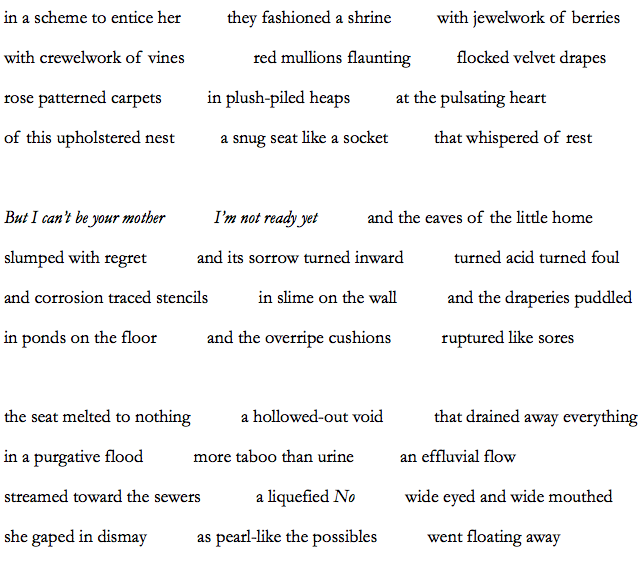
Monica Youn is the author of Blackacre, which is forthcoming from Graywolf Press in September 2016, Ignatz, which was a finalist for the National Book Award, and Barter. She teaches at Princeton and lives in Manhattan.
You will find more poems here. You may contact the editor at poems@theawl.com.
Kaitlyn Aurelia Smith, "Arthropoda"
To me it seems like a good name for this song would be “Morning in the Imperial City on Mars.” Like, can’t you see the dawn breaking over the gleaming, futuristic capital and all of its industrious, green-hued citizens waking up and standing out on their balconies in their flowing white robes singing their song of the sunrise or whatever? No? You have no idea what the fuck I’m talking about and that’s not at all what you get from this song, plus you think I’m kind of an idiot? That’s okay too. Just so long as you give it a listen. Anything Kaitlyn Aurelia Smith does is aces in my book. But maybe this is more your speed. Either way, enjoy.
New York City, January 26, 2016

★★★ The thaw was on in full, but it had a lot to do. Out in the mild morning, the corner of an eye caught sight of a taillight peeping out from a crack in what had seemed to be an ordinary snowbank. Various kinds of clouds tried to affect the sunlight one way or another, then yielded to others. Between snow dams at a crosswalk was a chunky ash-colored slush puddle. Then came a puddle of clear fresh meltwater, and then a clear puddle with ashy muck settled at the bottom. West End Avenue was still thickly coated in soft slush. The uncertain sky and the white snow and the grayer snow all resolved, at once, into a uniform twilight blue.
Remember Not Remembering the Eighties?

As remarkable as the speed of technological innovation is in our present day and age, it is nowhere near as breakneck as the pace at which fancy cocktails have progressed over the last several years. After spending the early-to-mid-aughts firmly rooted in the aesthetics and paraphernalia of speakeasies and other pre-Prohibition motifs — austere Old Fashioneds and Corpse Revivers and whatnot — the cocktail scene finally began moving forward, decades at a time. There was tiki — a look that is admittedly only just now peaking outside of NY and SF — with its oceans of juice and rum. And then, for a brief moment, the baroque grotesqueries of the sixties and seventies, with refined Long Island Iced Teas and upscaled fruit-packed Old Fashioneds and lots of brass and ferns.
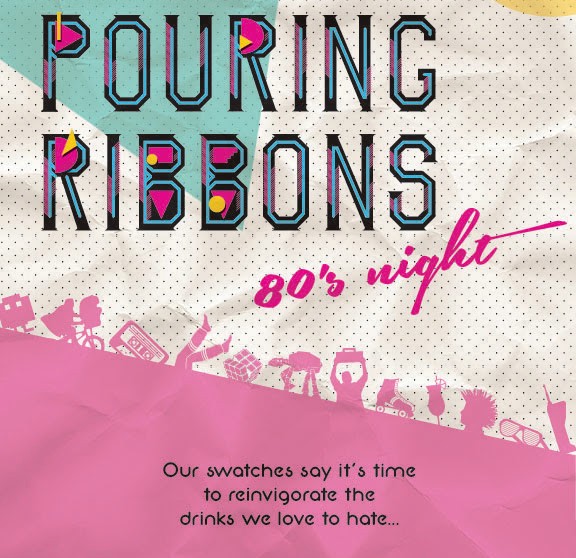
Now — so soon! — we have already arrived back at the eighties, judging by this flyer and promo for Pouring Ribbons, one of the more forward-thinking cocktail bars in New York City.
We unapologetically love the 80’s. How could you not appreciate the decade that gave us adventures like The Goonies, any band the chance to have at least one solid hit, and the cinematic promise of true love to any nerd that ever pined after the most popular babe in school? If only the cocktails had followed suit with an adequate level of awesomeness. Well, now we get the best of everything, because we’re grown-ups that don’t have to be embarrassed at rocking out to Johnny Hates Jazz, and we also know how to make a damned tasty drink. So dust off those pastels (or, you know, just buy something new at American Apparel) and join us on February 8th for the first of a monthly event that seeks to prove that an Appletini can be rad, a Slippery Nipple can actually be sexy, a Pink Squirrel can be anything other than gross…you get the idea. Neon-lit optimism is our noble goal and simply embracing the fun of one of our favorite periods in pop-culture history.
At this rate, kids who were born in the late nineties should be old enough to drink just in time to put down “reinvigorated” versions of the Cosmopolitans their parents drank when they were in their twenties, for only three times the price. Time is a flat coaster after all.
Photo by Emily Hager
Mattheis, "Deliberately Diverted"
If you are looking for something to put on in the background and forget about so that occasionally it can come up and tap you on the shoulder and say, “Hey, everything’s going to be okay,” this is the track for you. Enjoy.
An Income for Basics

A cheap way to read the startup incubator Y Combinator’s announcement of funding for a researcher to conduct a “a study on basic income — i.e., giving people enough money to live on with no strings attached” is to note that it is coming from a firm in the business of accelerating the creation and growth of the kinds of companies that will potentially put large numbers of people out of work, permanently, through automation, like anyone who drives any vehicle for a living.
A study out of Oxford that everyone likes to cite in order to pose a possible scenario of mass unemployment in the not-too-distant future estimated that “about 47 percent of total US employment is at risk” for being lost to “computerisation.” What to do with all of those people if we reach the “end of work” — and if we will reach it — is a thing that economists have loved to debate for a very long time. Some of them are very certain that the end of work is coming, they just don’t know what’s going to happen after it arrives; others, like venture capitalists in the business of profiting from the companies that stand to possibly precipitate labor disruptions like wide-scale unemployment think that everything will be fine because the Luddites were a bunch of short-sighted morons when they freaked out about being replaced by machines during the Industrial Revolution and everything is much better now than it was then, so they are not worried about it at all. (And maybe they’re right! That’s the cool thing about the future: No one knows.)
But there’s more. Paul Graham, the founder and philosopher king of Y Combinator, is already rather afraid of the poors who merely want to eliminate economic inequality. Or, as he put it in an earlier version of his essay, “Economic Inequality,” “when I hear people saying that economic inequality is bad and should be eliminated, I feel rather like a wild animal overhearing a conversation between hunters.” One can imagine how terrified a self-styled “manufacturer of economic inequality” must feel, then, at even the remote possibility of millions upon millions people left without work, all those losers fueled by the power of envy left with all the time in the world to plot how they would hunt and eat Paul Graham, especially if they were like, starving, because the companies funded by people like Paul Graham helped put them out of work.
But… what if we just paid people? To do nothing but drink Soylent and look at ads inside of their Oculus Rifts? And especially not eat Paul Graham? Definitely worth studying.
Image from “Cat In A Shark Costume Chases A Duck While Riding A Roomba”
Seb Wildblood & James Booth, "Lifestyle"
This track has been tagged “rainforest house,” so if that in some way amplifies your enjoyment of what is already an enjoyable tune, terrific. Otherwise just enjoy.
New York City, January 25, 2016

★★★ Sun lit up a newly furnished apartment so orderly behind its full-length windows that it must have been staged. Foil lettering glimmered on the dust jacket of the single thick book angled to touch two edges of the coffee table. The sky grew duller and duller gray-brown, but for a while the visible part of the water upriver shone argon blue. Ice had been embroidered into the scaffolding mesh by the icicles above. The generalized dripping was like a light rain. A snowball burst amid idling high schoolers, and the school-zone police barked, “Let’s go! Let’s go!” Two Bobcats were carving up the plowbank on the avenue and loading it into a dumpster. The light was starting to recover its strength. A metallic blue paisley necktie lay under dark slush in the street. Tires raised a sloshing sound from the avenue. The sun went down with a wash of clear red light through the gap between buildings.
The Shoes Under the Art World
The Shoes Under the Art World, Part II
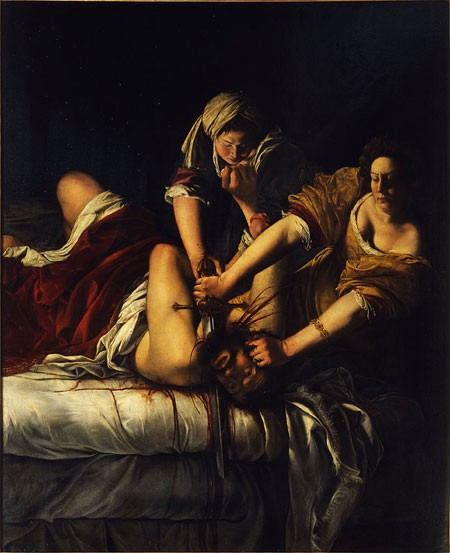
Judith Slaying Holofernes, Artemisa Gentelischi, 1620, Uffizi Gallery
“Society never advances. It recedes as fast on one side as it gains in the other.” Ralph Waldo Emerson, Self Reliance
1.
“The Shoes Under the Art World,” which was published on this site in October, was about how women have managed in contemporary and 20th century art. I’d never seen myself as a “woman painter,” but eventually it became obvious that’s how I was viewed; the piece was, essentially, about that. People love labels.
So I decided to check out the historical perspective: how had women painters fared in the past? I might have been smug about what would turn up — that although it’d been tough for women in the 20th century and recently, we’d done much better than our sisters from the Middle Ages through the early nineteenth century. In fact, I discovered the opposite: the percentage of women exhibiting their work was higher after the French Revolution in Paris than it is in New York now. Despite the bra burnings, Gloria Steinem, the Guerrilla Girls, and ongoing feminist rhetoric. From the 17th to the 19th century, Salons in France were official art exhibitions controlled by the government-run Academy of Painting and Sculpture. Here’s the breakdown of women to men showing their work: In the Salon of 1801, 192 painters exhibited, of those 28 or 14.6 % were women. In the salon of 1810, 390 painters exhibited, of those 70, or 17.9%, were women, and in the Salon of 1822, 475 painters exhibited, of whom 67, or 14%, were women.
Now let’s look at the present. In “Shoes,” I mentioned the reopening of MoMA in 2004. Of 400 objects exhibited in the museum, 16 — that is to say about 4% — came from female artists. Today, at three super-prestigious New York galleries, I found three women out of 20 artists mentioned on the official roster of Sperone Westwater — that is 15%. (All shown, incidentally, with serious black and white photographs next to their names, making it difficult to tell what sex they are.) At Gagosian, among the 39 artists listed as the gallery’s inner core, three are women: 7%. The third gallery, Pace, specifies 90 artists, seven of whom are women; that is to say 7.78%. So, compared with Paris in 1820 the percentage of women in New York showing in 2015 is down drastically. Plus ça change, plus c’est la même chose.
2.
What about fame and recognition? Amazingly, there too contemporary female painters trail behind. During the Renaissance and for a time following, several women gained recognition and fame unrivalled since. (Even if those very same women and their work are now largely forgotten.) During their lifetimes they were sought after throughout Europe — sometimes serving as court painters–with commissions and stipends, and eventually becoming wealthy from the sale of their paintings. Who knew? I’d always thought women had pretty much — with the exception of Madame Curie — been at home cooking, cleaning, doing embroidery, even spinning, like the miller’s daughter in Rumplestiltskin. It seems that was not the case.
For instance, between 900 and 1300, women in Germany, Spain and Alsace participated in making illuminated manuscripts. Back in 975, Ende, a Spanish nun, signed the “Gerona Beatus” as “Woman painter.” This was followed by the signature of her male assistant, Emetrius, rendered as “Monk.” In 1180, another woman, from Alsace, Herrad of Landsburg, left us a self-portrait on the cover of “Hortus Deliciarum,” a pictorial encyclopedia she also wrote and organized. As well as working on manuscripts, during the Middle Ages women were allowed to join guilds and conduct business. This changed when painting moved into studios, after which women were largely kept out.
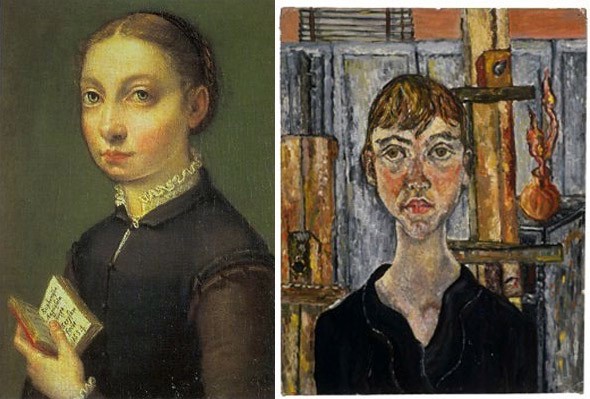
Self portrait, Sofonisba Anguissola, 1554; Self portrait Pat Lipsky, 1957
Despite this prohibition, from the 16th to the beginning of the 19th century there were several women painters who were wildly successful: Sofonisba Anguissola, Lavinia Fontana, Elisabetta Sirani, Artemisia Gentileschi, and Élisabeth Vigée Le Brun, to name five. (Know any of these?) These painters were sought after by royalty for their portraits; given prestigious commissions by the court and altarpiece commissions by the Church; received awards and medals and were members of the Academy. With the possible exception of Georgia O’Keefe–her flower paintings along with nude photographs taken by her husband, Alfred Steiglitz, made her famous — no contemporary female has been as well known in her lifetime as these early women.
Let’s take a look. First, Sofonisba Anguissola (1532–1625). Milk-fed as I’d been on important male artists, I’d never heard of her. Yet she’d received training from Michelangelo, been court painter to King Philip II and his wife, and was known as an intellectual in her time. Anguissola was a truly independent woman, able to support her whole family from sales of her pictures. Coming from an aristocratic family there was less pressure on her to marry. (Which meant no pregnancies.) Only at age 40, when King Philip II gave her a dowry, did she submit to matrimony. (The three great male artists of the Renaissance — Botticelli, Leonardo, and Michelangelo — never married.)
When she was 22, Anguissola was introduced to the sculptor in Rome. She managed to maneuver this meeting into an informal study. He asked her to draw a weeping boy, and she created the charming “Boy Bitten by a Crayfish.” Michelangelo immediately recognized her talent. He then gave her sketches from his notebooks to draw in her own style and offered advice on the results. The greatest Renaissance Master coached her for at least two years. Sound like the art world now?
During her lifetime she was a household name in literate Italy. In addition to being court painter, she had a substantial stipend from the court and commissions from the aristocracy. Anguissola completed more than seven self-portraits over 93 years. (Painting my second one in 1957, I was completely unaware that this great female artist had started a tradition of women painting their own faces on canvas 400 years prior.)
First in 1554, there is a soulful self-portrait of Sofonisba, age 22, holding a book. (The inscription reads, “Sofonisba Anguissola, a virgin made this herself in 1554.”) Last, her self-portrait from 1610 shows the artist at age 77 without good dental care–one thing that actually has improved. And there’s even a final portrait of her at 93 by Anthony Van Dyck, who visited Anguissola in her last year in Sicily. He claimed their conversation taught him more about the “true principles” of painting than anything else in his life. (That painting hangs at the Dulwich Picture Gallery in England.) Why are these self-portraits nearly forgotten, except by experts in art history?
Lavinia Fontana (1552–1614), was from Bologna and was trained by her father, a leading Bolognese painter. There were paintings in town by Raphael, Guido Reni, and Perugino, so she had plenty to look at. But for a role model she chose Anguissola. Fontana’s unique reputation is based on the public commissions for altarpieces she received — the most important sign of success in Catholic Europe. She was paid the huge sum of 1000 ducats by King Philip II for her Holy Family altarpiece for the Spanish family palace in Escorial, Madrid. There were also public commissions for large paintings of religious and mythological subjects. She was considered a colorist, a bit of a put-down back then when drawing was thought more important. (The Florentines, particularly Michelangelo, believed that everything worthy in a painting sprung from drawing, putting color in second place — disegno vs colore.)
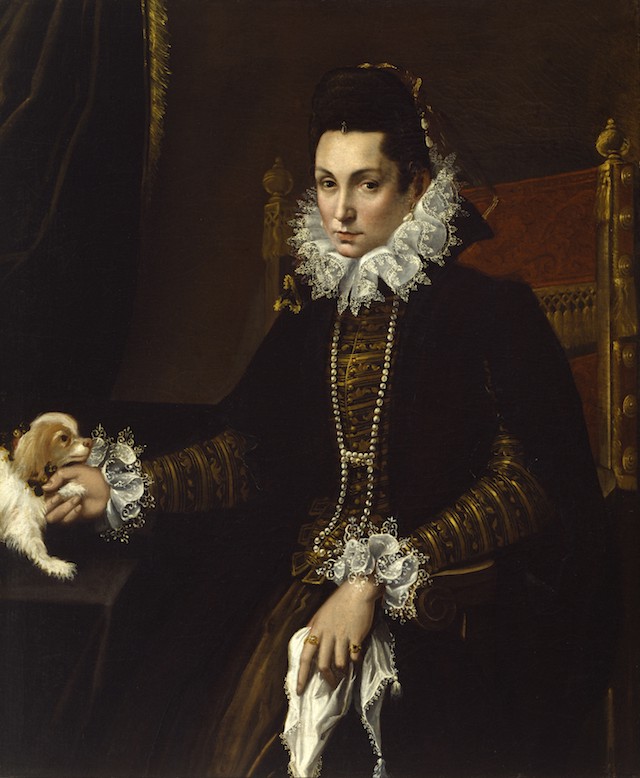
Portrait of Ginevra Aldrovandi Hercolani, Fontana, 1595, Walters collection
She married a wealthy artist, Giovanni Zappi, who, aware of her superior talent, quit painting and became her agent. In Bologna she became the preferred portrait painter. One of her noble patrons refers to Fontana’s portrait as “a great and beautiful picture by the hand of Lavinia Fontana the famous painter honored in everything.” In 1603 they moved to Rome at the invitation of Pope Clement VIII, where Fontana was named court portraitist and became a member of the Royal Academy. Today she’s listed among “The 100 Most Influential Painters and Sculptors of the Renaissance.”
Fontana was the first woman to have a career on par with successful men of her time. (And her breakthrough is greater than what women have been able to achieve since, including the present moment when we are pushed behind by the likes of Koons, Stella, Hirst, Wool, Basquiat.) Of course the field has always been prejudiced against women, as Francine Prose wrote in her new biography of Peggy Guggenheim: “The …ingénue we encounter in the pages of her book was only a partial representation of the determined woman who worked hard and overcame any number of obstacles (not least, the prejudice against women then and now).”
Lavinia bore a staggering eleven children (only three survived). Her own death at age 62 followed that of her youngest daughter who was 14 and gifted in drawing. (Or maybe Fontana was just exhausted from the cumulative effect of carrying on a career and enduring all those pregnancies?) In 1588, one of her patrons stated: “This excellent painter to say the truth, in every way prevails above the condition of her sex and is a most remarkable person.” But an art critic of the time wrote, “After all she was competing with, and often surpassing male artists in Rome. The things of Lavinia are valued in all Italy, and it is true that they do not have the excellence and valor to be found in such things by great men, because they are after all by a woman who has left the usual path and all which is suitable to their hands and fingers.” (The cost.)
Less well-known is Elisabetta Sirani (1638–1665), also from Bologna. The ground-breaking university, the oldest in the Western Europe, influenced the town. It was the only city during the Renaissance that allowed women to excel at a profession. Like Anguissola and Lavinia, but with a much shorter life span, Sirani broke through whatever barriers existed to become one of the most famous artists of her time. (Even Cosimo de Medici commissioned her work.)
Being precocious and beautiful, as I’ve said, were prerequisites for women who succeeded in the art world (then and now). Sirani was known for both. In addition, she was so confident in her skill that she’d finish a painting while the commissioning patron stood by and watched. (The patron was then free to take the work home the next day when it dried.) This virtuosity made her a tourist attraction, bringing visitors from Florence, Mantua, Turin and even out side Italy to her studio in Bologna.
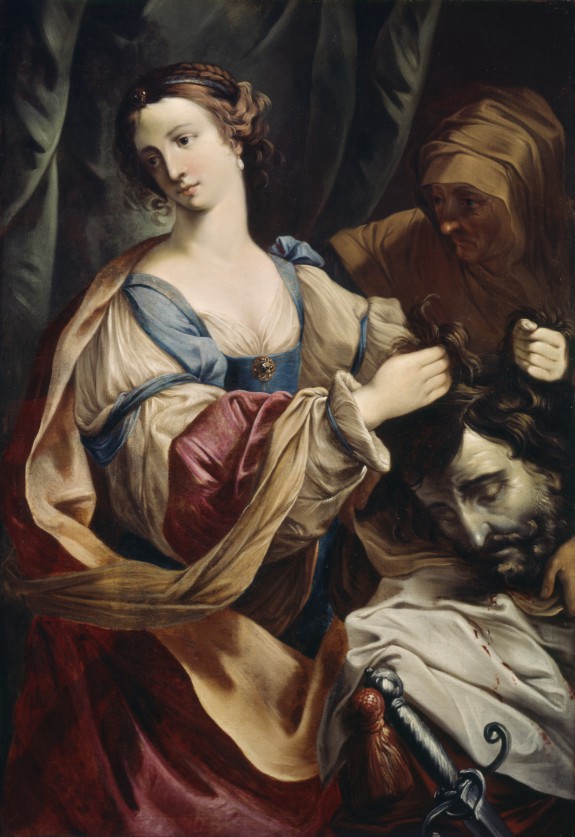
Judith with the head of Holofernes, Elisabetta Sirani, 1658
From ages 16 to 27 she supported her entire family, and then, tragically, Sirani died from what’s since been diagnosed as an ulcer. But during her short life span she created over 100 paintings — five times the number left by Vermeer. At her death the town leaders decided to bury Sirani in the tomb next to Guido Reni, one of the big art stars of Bologna. Yet who remembers her work?
Artemisia Gentileschi (1593–1656), was born in Rome to a family of artists; not only her father, but also her grandfather, and uncle were painters. Again beautiful and talented — a woman who sparkled in the elite artistic circles of her time. Much has been written that mentions her brilliance and popularity. Artemisia remains one of the most intriguing and dramatic women in art history. Even her name is dramatic — and swanky. Pronouncing its five syllables pleasures the tongue. Its first three letters spell Art.
Artemisia eventually became a top seller. During the time she lived in Florence, she traveled with the “in” crowd — no less than Galileo and Michelangelo’s great nephew, Michelangelo Buonarroti the Younger. As well as being the first woman admitted to the Accademia dell’Arte she was the breadwinner for her family while her ne’er-do-well husband kept the books.
The prejudices that held women back did not seem to affect Artemisia. Throughout her numerous pregnancies she continued to paint, her stomach touching the canvas. Refusing second-class status, Artemisia asked for and commanded high prices. And when it came down to the contest between art and love, she chose art.
Orazio, her father, a friend and follower of Caravaggio, was a great painter in his own right. Recognizing her talent as a child, he trained Artemisia, which meant she also got to draw from the nude models hanging about his studio. (As I mentioned, women painters were considered too delicate to be in classes for figure drawing until the late nineteenth century.) Less conventional still, she posed nude for her father and appears in some of his pictures. Nor did she submit to the portrait/still-life limitation imposed on women of her time. (They could only do portrait and still life subjects because they were considered incapable of taking on more complex, and prestigious topics like History Painting or Paintings Depicting Greek Myth.) Completely rejecting this, Artemisia confined herself to painting historical and biblical pictures that featured strong women who triumph. Perhaps her most famous picture (in two versions) is “Judith Cutting the Head of Holofernes,” blood spurting everywhere. The one we have in New York is “Esther before Ahasuerus,” a large painting, in which Esther appears before the foppish king, swooning from a three-day fast to show her emotional state.
Inevitably, a competition between Artemisia and her father occurred. He feared Artemisia would pass on the painting secrets he’d taught her, or simply surpass him. On her end, she simply found it necessary to escape his influence. But later, when the old man was dying and overwhelmed with a commission from the English Queen, Artemisia came to finish the ceiling painting cycle, “Allegory of Peace and the Arts under the English Crown.” Ultimately, their relationship can be seen as something of a father/daughter love story.
She wrote to her patron, Don Antonio Ruffo, who owned several paintings of hers, including a self portrait, “I have the greatest sympathy for your lordship because the name of a woman makes one doubtful until one has seen the work.” Calling a spade a spade! It is believed that she lived on until 1656, succumbing to a plague that hit Naples.
We wait another hundred years for the French painter, Vigée Le Brun (1755–1842). Like Artemisia her father was a painter, and she had all the requirements of that time for women painters — precocious, beautiful and talented. Vigée Le Brun’s first big break was being appointed court painter to Marie Antoinette. She’d run up to Versailles every week to work on portraits of Marie and the kids. Marie hiring a female painter perhaps started the tradition of an “old-girls thing,” like Philip IV naming Velàzquez court painter. (The king anointed whomever became court painter–it was like being picked by Leonard Bernstein to play in the New York Philharmonic.)
Receiving this appointment made Vigée famous. Unfortunately, though, with the French Revolution and the Queen’s beheading, things quickly fell apart. The painter had to make a hasty retreat out of Paris lest she suffer the same fate. (Not the worst thing in the world, as she loved travel.) In Italy, Russia, and Spain she was wined and dined by the upper class and royalty. Portrait commissions poured in — everyone wanted to be painted by Vigée Le Brun. Nor were her prices lower than those of her male contemporaries. She was a celebrity, always staying with the king, or countess, in the fanciest castle. Only in the 1940’s did Simone de Beauvoir have the nerve to give Vigée a negative diagnosis. Writing about her portraits she implicated motherhood. (The painter had one daughter.) “Vigée [is] primarily [seen] as a narcissist painter who never wearied of putting her own self or ‘her smiling maternity’ onto her canvas.”
Like other women I’ve mentioned she supported her family, but in her case, even earlier, at age 15. Later she was forced to pick up her husband’s gambling debts. She, like Anguissola, was long lived, dying in her sleep at age 83.
It’s hard to imagine Vigée LeBrun giving into the situation that confronted the less fortunate Mari-Guillemine Benoist, a student of Jacque Louis David. She is the painter of the magnificent Portrait d’une négress that stares out at the visitor from a wall at the Louvre. In 1806 Benoist was ordered by the state to, in essence, stop painting, and she did. Her husband Pierre Vincent Benoist had won a prestigious government job, with one stipulation: that his wife no longer paint. She wrote to her husband, “Don’t be angry with me, if at first my heart bled at the course I was forced to take–and ultimately to satisfy a prejudice of society to which one must after all submit. But so much study, so many efforts, a life of hard work, and after that a long time of testing–successes–and then to see them almost the object of humiliation.” Unlike the other woman I’ve mentioned this painter did not triumph over the prejudice of that day.
3.
What if, for a few months, women’s art, from the first illuminated manuscripts to the present, was all that hung in the painting rooms of a major art museum? No men’s work whatsoever. Would a totally different vision emerge?
Not that this fantasy is feasible, since so many paintings by women have been lost — through misattribution, lack of good records, or simple lack of care. And why is a painting by a woman so often located in a minor or distant collection like the National Museum in Poznan Poland, or the Palazzo Blu in Pisa?
As you tour the Metropolitan Museum’s second-floor collection, as I wrote before, it’s “a mobile Virginia Slims ad” in which women are subjects, rarely creators. What you see is about one female painting for every 200 by a man — if that. Listed in the collection on their website are only 14 pictures by women in the 19th century; seven in the 18th century; and before that, perhaps five or six. Passing from room to room there is very little made by the female hand. The one painting by Artemisia Gentileschi I mentioned was only acquired by the Met in 1969. So young women art students prior to that time would have seen hardly anything from the Baroque by a woman. Even now, the museum has relatively few “Old Mistress” paintings. (Of course the term “Old Master” says it all.)
There are often rumblings in the art world about the under-representation of female artists, but are people really aware of how drastic and out of proportion the numbers are? These concerns are usually lumped together with under-representation in general: of minorities and ethnicities, i.e. all we “others.” (And no one wants to be in that “other,” ultimately less desirable group. It’s like Woody Allen in Stardust Memories clawing at the windows to get out when he finds himself on the wrong train.)
Once, I was asked by The SoHo Newsletter to write about myself as a “woman painter.” My answer was I didn’t see myself that way at all, but simply as a painter, trying to do the best work I could. It turns out to have been a naïve, almost delusional response. Once people got passed the androgyny of my name, the way they thought of me was: woman, female, not male painter. (And unlike George Sand, I didn’t take on a lower voice and dress in drag.)
Let’s be honest, “woman” in front of anything usually has a pejorative ring. Like the phrase “woman doctor.” As soon as you say, “I went to the doctor,” the other person says, “What did he say?” Maybe the time will come when that is no longer the case? The fact that still today women are considered inferior, less likely to excel, or less able to master things like math, science–let alone painting and sculpture — speaks for itself. At the same time it doesn’t quite make sense. After all we are one-half of the human race. How could a group that large be inferior? Different, yes, with a different anatomy, but not a brain that doesn’t work as well. I defy anyone looking at a painting with no wall label to say whether it was painted by a woman or a man.
Corrections: The “Guerrilla Girls” was originally misspelled, and proportional calculations regarding historical and current representations of women painters have been corrected. We regret the errors.
